You Continue Your Analysis by Crossing the Forked and Twist Lines Your Results Are as Follows
Here is a PDF for the answers for the packet for this chapter.
ch14answers
***
Use control+F (Command+F for mac) to search this page for the answer. User either Chapter 14 Question __ or some part of the question to easily find the answer.
***
Chapter 14 Question 19
Albinism is an autosomal (not sex-linked) recessive trait. A man and woman are both of normal pigmentation and have one child out of three who is albino (without melanin pigmentation). What are the genotypes of the albino's parents?

Chapter 14 Question 20
A black guinea pig crossed with an albino guinea pig produced twelve black offspring. When the albino was crossed with a second black animal, six blacks and six albinos were obtained. What is the best explanation for this genetic situation?

Chapter 14 Question 31
Phenylketonuria is an inherited disease caused by a recessive autosomal allele. If a woman and her husband are both carriers, what is the probability that their first child will be a phenotypically normal girl?

Chapter 14 Question 32
Assuming independent assortment for all gene pairs, what is the probability that the following parents, AABbCc × AaBbCc, will produce an AaBbCc offspring?
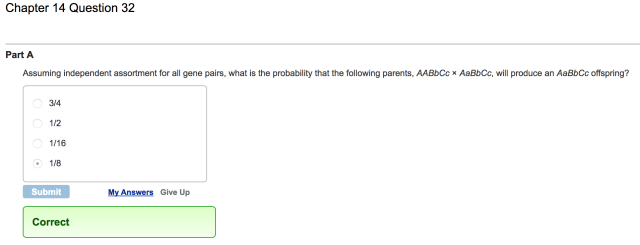
Chapter 14 Question 51
In humans, ABO blood types refer to glycoproteins in the membranes of red blood cells. There are three alleles for this autosomal gene: IA, IB, and i. The IA allele codes for the A glycoprotein, The IB allele codes for the B glycoprotein, and the i allele doesn't code for any membrane glycoprotein. IA and IB are codominant, and i is recessive to both IA and IB. People with type A blood have the genotypes IAIA orIAi, people with type B blood are IBIB or IBi, people with type AB blood are IAIB, and people with type O blood are ii. If a woman with type AB blood marries a man with type O blood, which of the following blood types could their children possibly have?

Chapter 14 Question 36
Which of the following is an example of polygenic inheritance?

Chapter 14 Question 38
Which of the following provides an example of epistasis?

Chapter 14 Pre-Test Question 2
Which of the following is true about a plant with the genotype AABbcc?

Chapter 14 Pre-Test Question 4
Consider pea plants with the genotypes GgTt and ggtt . These plants can each produce how many type(s) of gametes?

Chapter 14 Pre-Test Question 5
Two organisms with genotype AaBbCcDdEE mate. These loci are all independent. What fraction of the offspring will have the same genotype as the parents?

Chapter 14 Pre-Test Question 8
Folk singer Woody Guthrie died of Huntington's disease, an autosomal dominant disorder. Which statement below must be true?

Chapter 14 Question 2
A man with type A blood marries a woman with type B blood. Their child has type O blood.
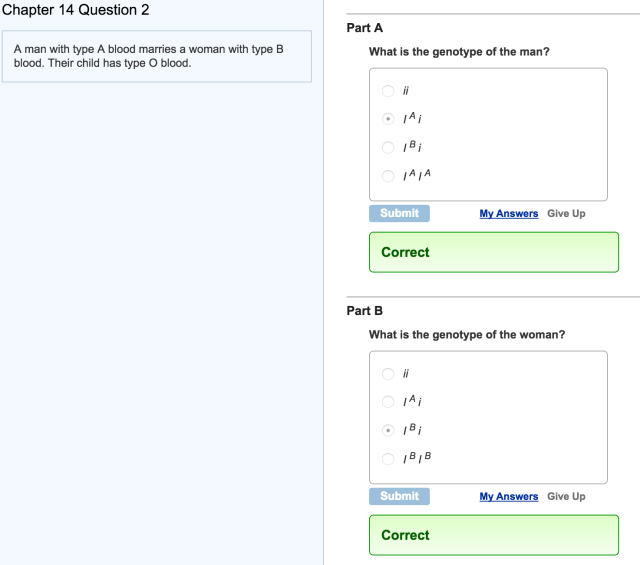
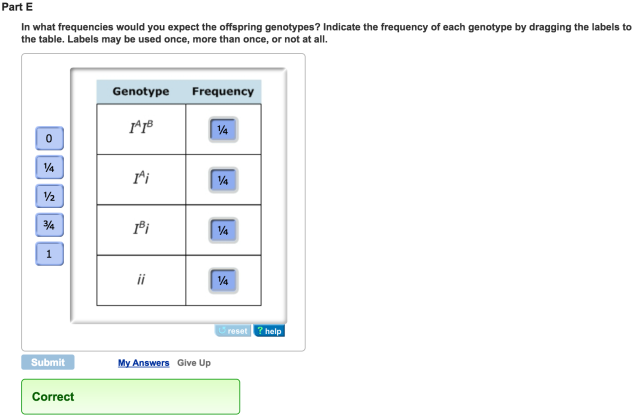
Determining Genotype: Pea Pod Color
A botanist has acquired a group of sweet pea plants. All of the plants have yellow pea pods (the recessive trait), except for one, which has green pea pods (the dominant trait). Pea pod color is a trait caused by a single gene. In this tutorial, you will determine how the botanist can identify the genotype of the green pea pod, and how this relates to Mendel's laws and meiosis.




Activity: The Principle of Independent Assortment
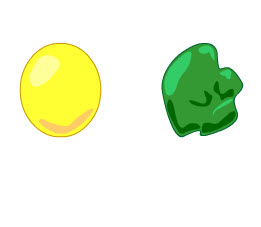
View this animation. Then answer the questions.



Misconception Question 68
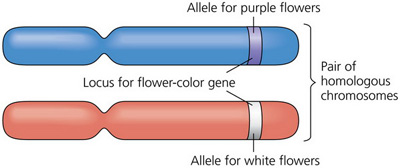
Each chromosome in this homologous pair possesses a different allele for flower color. Which statement about this homologous pair of chromosomes is correct?

Misconception Question 67
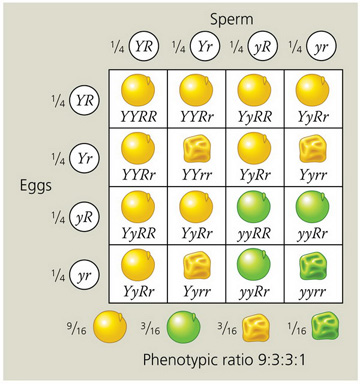
Look at the Punnett square, which shows the predicted offspring of the F2 generation from a cross between a plant with yellow-round seeds (YYRR) and a plant with green-wrinkled seeds (yyrr). Select the correct statement about wrinkled yellow seeds in the F2 generation.

Chapter 14 Question 60
The figure below shows the pedigree for a family. Dark-shaded symbols represent individuals with one of the two major types of colon cancer. Numbers under the symbols are the individual's age at the time of diagnosis. Males are represented by squares, females by circles.
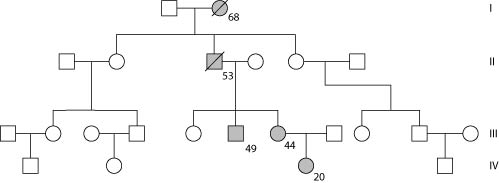
From this pedigree, this trait seems to be inherited _____.

Chapter 14 Question 49
The following question refer to the pedigree chart in the figure below for a family, some of whose members exhibit the dominant trait, W. Affected individuals are indicated by a dark square or circle.
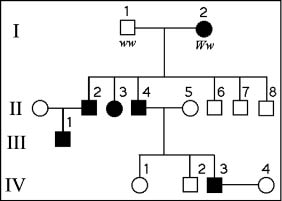
What is the probability that individual III-1 is Ww?
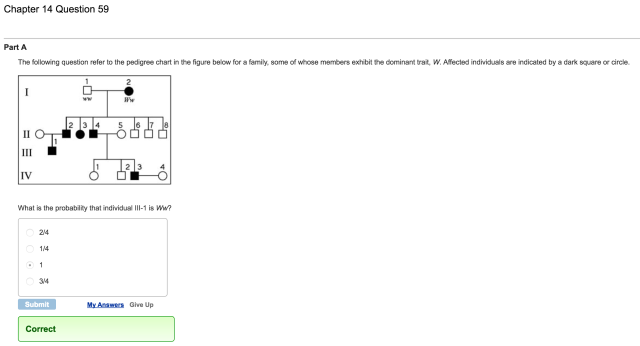
Incomplete Dominance and Codominance
You decide to conduct a genetic analysis of these mutant lines by crossing each with a pure wild-type line. The numbers in the F2 indicate the number of progeny in each phenotypic class.
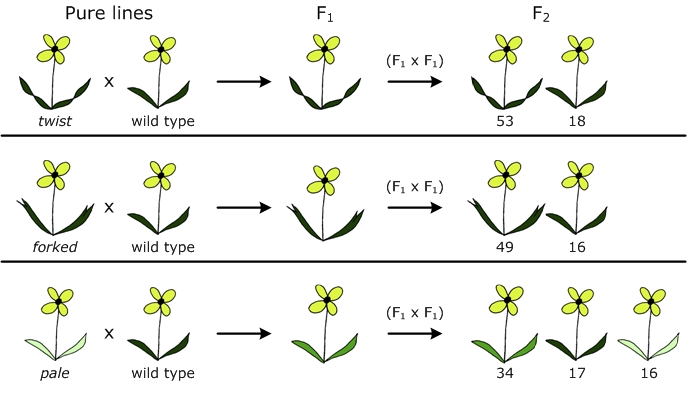
From these results, determine the relationship between the mutant allele and its corresponding wild-type allele in each line.
Label each mutant line with the best statement from the list below. Labels may be used once, more than once, or not at all.

You continue your genetic analysis by crossing the forked and pale mutant lines with each other. The leaves of the F1 are light green (intermediate between pale and wild-type leaves) and forked. The F2 has six phenotypic classes, as shown below.You designate the forked mutant allele as F (wild type = f+ ) and the pale mutant allele as p (wild type = P).
- Consider the alleles for leaf color first. Drag the white labels to the white targets to identify the genotype of each F2 class. Remember that p (the pale mutant allele) and P (the wild-type allele) are incompletely dominant to each other.
- Consider the alleles for leaf shape next. Drag the blue labels to the blue targets to identify the genotype of each F2 class. Remember that F (the forked mutant allele) is dominant to f +(the wild-type allele).
Labels may be used once, more than once, or not at all. For help getting started, see the hints.

You continue your analysis by crossing the forked and twist lines. Your results are as follows:

Which of the following statements best explains the outcome of this cross?

You decide to designate the twist allele as FT to distinguish it from the forked allele F.
Using the following allele symbols, identify the genotypes of the three F2 classes in Part C by dragging one label to each class. Labels may be used once, more than once, or not at all.

Chapter 14 Question 54
Phenylketonuria (PKU) is a recessive human disorder in which an individual cannot appropriately metabolize the amino acid phenylalanine. This amino acid is not naturally produced by humans. Therefore, the most efficient and effective treatment is which of the following?

Chapter 14 Question 57
The following question refer to the pedigree chart in the figure below for a family, some of whose members exhibit the dominant trait, W. Affected individuals are indicated by a dark square or circle.

What is the genotype of individual II-5?

Chapter 14 Question 56
One of two major forms of a human condition called neurofibromatosis (NF 1) is inherited as a dominant gene, although it may range from mildly to very severely expressed. Which of the following is the best explanation for why a young, affected child is the first in her family to be diagnosed?

Activity: Mendel's Experiments
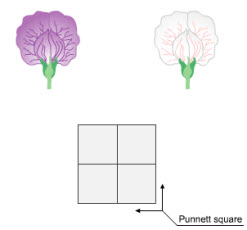
Click here to view this animation.
Then answer the questions.
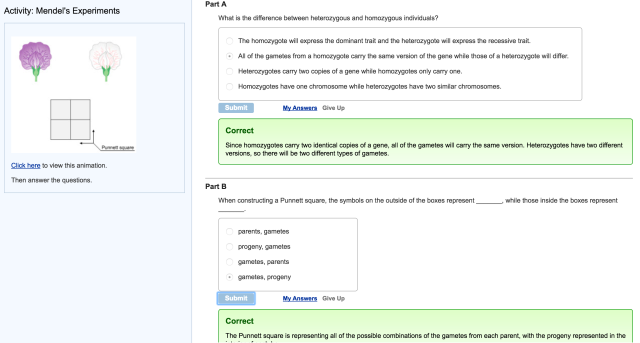
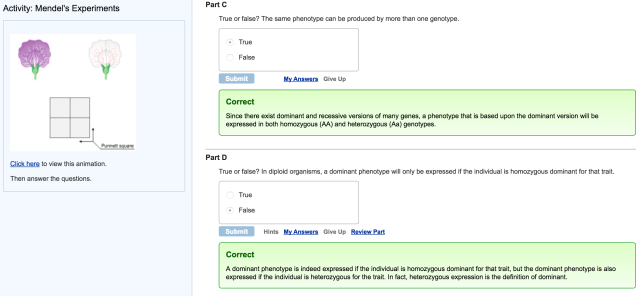
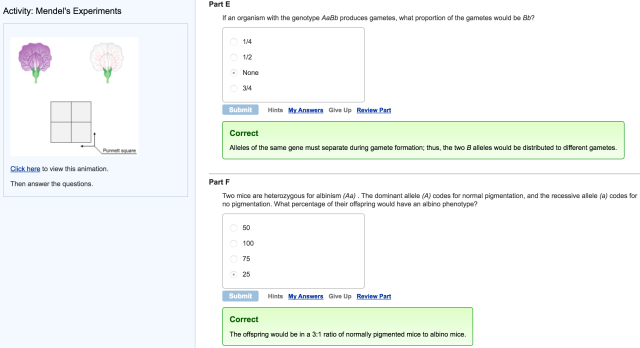

Chapter 14 Pre-Test Question 1
In his breeding experiments, Mendel first crossed true-breeding plants to produce a second generation, which were then allowed to self-pollinate to generate the offspring. How do we name these three generations?

Pedigree Analysis: Dominant and Recessive Autosomal Conditions
Geneticists analyze pedigrees to follow the inheritance of genetically controlled conditions. Three things must be determined in a pedigree analysis:
- The mode of inheritance of the condition. In this tutorial, this means deciding if a condition is caused by an autosomal dominant or autosomal recessive allele.
- The genotypes of individuals in the pedigree (as far as can be known) based on their phenotype and the phenotypes of their parents or children.
- The probability that certain individuals will have the condition. This requires assigning probability values to some individuals whose genotypes cannot be determined with certainty. It also requires an understanding of how and when to apply the multiplication and addition rules.
Part A – Determining the mode of inheritance
The pedigrees below show the inheritance of three separate, rare autosomal conditions in different families. For each pedigree, decide if the condition is better explained as recessive or dominant.
Drag the correct label to the appropriate location. Labels can be used once, more than once, or not at all.

Part B – Determining genotypes in autosomal dominant pedigrees
Pedigree 2 from Part A is shown below. Recall that this pedigree shows the inheritance of a rare, autosomal dominant condition.
Fill in the genotypes for the indicated individuals in the pedigree by dragging the best label to the appropriate location. Labels can be used once, more than once, or not at all.

Part C – Determining genotypes in autosomal recessive pedigrees
Pedigree 3 from Part A is shown below. Recall that this pedigree shows the inheritance of a rare, autosomal recessive condition.
Note that individual II-3 has no family history of this rare condition.
Fill in the genotypes for the indicated individuals in the pedigree by dragging the best label to the appropriate location. Labels can be used once, more than once, or not at all.

Part D – Calculating probabilities in pedigrees
The pedigree from Part C is shown below.

Individuals III-3 and III-4 are expecting their first child when they become aware that they both have a family history of this recessive condition. As their genetic counselor, you can calculate the probability that they are carriers and that their child will be affected with the condition.
Complete each statement by dragging the correct label to the appropriate location. Labels can be used once, more than once, or not at all.

Source: https://rhshwhelp.wordpress.com/tag/chapter-14/

0 Response to "You Continue Your Analysis by Crossing the Forked and Twist Lines Your Results Are as Follows"
Post a Comment